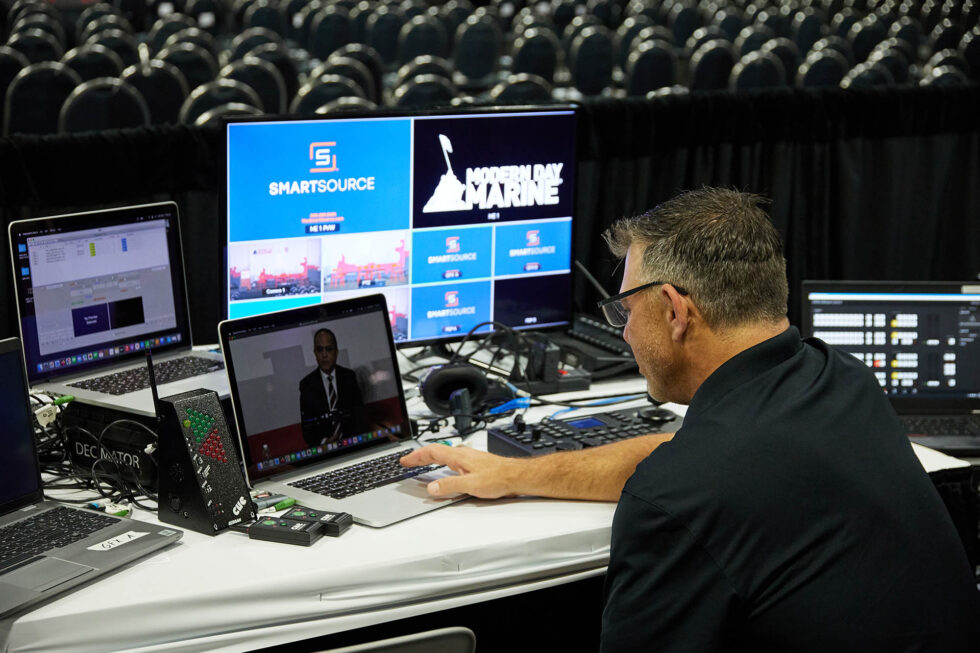Navigating the audio visual (AV) technology world can be daunting for even the most seasoned event planners and corporate event organizers.
Knowing the right terminology, especially when starting out in the events industry, will help you communicate effectively with your event AV team and ensure your events run smoothly and professionally.
This glossary aims to provide a comprehensive list of standard terms used in event AV, their definitions, and examples so you can confidently discuss your AV needs with your team.
KEY EVENT AV TERMS AND APPLICATIONS

ASPECT RATIO
Definition: The proportional relationship between an image’s width and height.
Importance in Event Planning: Understanding aspect ratio is essential when designing presentations or digital displays, ensuring images and videos appear correctly without distortion on stage.
Example: If you’re projecting a speaker’s slides at a conference, knowing whether to use a 16:9 or 4:3 aspect ratio can significantly affect the presentation quality. For example, 16:9 is the native aspect ratio of most high-definition widescreen LCD monitors and TVs and is one-third wider than a 4:3 screen.
LED WALL
Definition: A display screen comprising individual LED tiles providing high-resolution images.
Importance in Event Planning: LED walls offer vibrant and dynamic visual displays, perfect for enhancing the atmosphere and engagement of an event, showcasing brand visuals or live video footage. They are also more easily customizable than traditional projection screens.
Example: An LED wall can be used for a product launch to create an impactful backdrop that showcases your brand’s visuals in stunning detail.
LAVALIER MICROPHONE
Definition: A small, discreet microphone often worn on the lapel, commonly used in public speaking.
Importance in Event Planning: Lavalier microphones offer hands-free operation, allowing speakers to move freely while maintaining excellent audio quality.
Example: Equip keynote speakers with Lavalier microphones during a conference to reduce the opportunity for muffled sound and ensure that all attendees hear presentations clearly.
PROJECTOR LUMENS
Definition: The measure of light output from a projector, affecting brightness and display quality.
Importance in Event Planning: Choosing a projector with the appropriate lumens is vital for visibility, especially in well-lit environments or large venues. If you need your visuals to be clearly visible from all angles, this is especially important.
Example: A projector with high lumens is necessary for a daytime outdoor event to ensure content remains visible and engaging in areas where natural light or glare could affect the screen.
SOUNDBOARD
Definition: The device used to control and adjust the volume and quality of sound at an event.
Importance in Event Planning: A soundboard allows for precise audio control, such as adjusting the volume of microphones, speakers, and background music levels to create a balanced sound experience for attendees.
Example: Implement a soundboard to manage various audio inputs during a panel discussion on stage, ensuring a seamless auditory experience for the audience.
HDMI
Definition: High-Definition Multimedia Interface, a standard for transferring digital video and audio.
Importance in Event Planning: HDMI cables are vital for connecting devices like computers and projectors, ensuring high-quality video and audio transmission.
Example: Use HDMI cables to connect laptops to projectors during a business seminar for crisp, clear presentations.
PROJECTION MAPPING
Definition: The process of projecting video or images onto irregular surfaces to create immersive experiences.
Importance in Event Planning: Video mapping can transform ordinary venues into extraordinary spaces, captivating attendees and enhancing an event’s impact.
Example: Project animations onto building facades to create a mesmerizing visual display for guests at a gala.
RESOLUTION
Definition: The number of pixels displayed in an image, determining its clarity and quality.
Importance in Event Planning: High-resolution displays ensure that content appears sharp and professional, which is crucial for maintaining a polished image.
Example: Choose high-resolution screens for an exhibition booth to present product visuals with stunning clarity and detail, helping to sell your brand or products to potential clients.
LINE ARRAY
Definition: A speaker system that uses multiple loudspeakers in a line to provide even sound coverage.
Importance in Event Planning: Line array systems deliver consistent audio quality, essential for large event venues where sound needs to reach every corner.
Example: Utilize a line array system in a large keynote session, ensuring every attendee, from front row to back row, hears the conversation with clarity.
RIGGING
Definition: In the AV context, rigging refers to hanging lighting, projectors, and other equipment above event spaces.
Importance in Event Planning: Rigging ensures that equipment is safely and effectively positioned for both functionality and safety.
Example: Use rigging to install a truss system in a concert venue, providing the necessary infrastructure for lighting and visual effects so that audio and visual displays are optimized for the event.
EXPERTLY PLAN THE AV FOR YOUR NEXT EVENT

Hopefully, this article has helped you understand essential AV terms and considerations for their use when planning your next event.
By grasping the significance of elements like aspect ratio, LED walls, and soundboards, you can craft engaging and compelling visual and auditory experiences. Whether you’re planning a small seminar or a large-scale conference, integrating advanced AV solutions can elevate your event’s success.
Partner with SmartSource to access innovative AV technology and expert advice to take your event to the next level.

